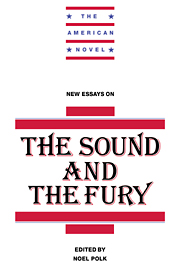Book contents
- Frontmatter
- Contents
- Series Editor's Preface
- 1 Introduction
- 2 Faulkner's Text Which Is Not One
- 3 “Now I Can Write”: Faulkner's Novel of Invention
- 4 Quentin Compson: Tyrrhenian Vase or Crucible of Race?
- 5 Trying Not to Say: A Primer on the Language of The Sound and the Fury
- Notes on Contributors
- Selected Bibliography
1 - Introduction
Published online by Cambridge University Press: 23 December 2009
- Frontmatter
- Contents
- Series Editor's Preface
- 1 Introduction
- 2 Faulkner's Text Which Is Not One
- 3 “Now I Can Write”: Faulkner's Novel of Invention
- 4 Quentin Compson: Tyrrhenian Vase or Crucible of Race?
- 5 Trying Not to Say: A Primer on the Language of The Sound and the Fury
- Notes on Contributors
- Selected Bibliography
Summary
THE SOUND AND THE FURY is the quintessential American high modernist text. For over sixty years now, but especially since its sudden “discovery” by readers and critics in the late forties and early fifties, it has attracted the attention of most major critics and nearly every major critical movement. It has been a sort of litmus paper on which critical approaches have tested themselves, from Marxism to New Criticism, to Structuralism and Poststructuralism, Deconstruction, Psychoanalytics, Linguistics, Feminism, and New Historicism, all of which seem to find it among the sine qua nons of its particular approach. Because it is so rich, so astonishingly full of the mainstreams of twentieth-century culture, it stands in a reciprocal relationship to us: it opens itself up to economic, historical, philosophical, religious, cultural, and social analyses, and in its reflecting turn enables us to see how profoundly all these streams are related to each other, and to us. Each of these approaches has enriched our understanding of the novel (though not all readings have done so), and it has generously given us back ourselves. Even so, if the amount of current critical activity involving The Sound and the Fury is any indication, it remains a Matterhorn of seemingly inexhaustible splendor, with unsealed faces we haven't even discovered yet.
Faulkner's fourth completed novel, The Sound and the Fury comes in his career at the end of more than a decade of feverish reading and writing.
- Type
- Chapter
- Information
- New Essays on The Sound and the Fury , pp. 1 - 22Publisher: Cambridge University PressPrint publication year: 1993
- 1
- Cited by

